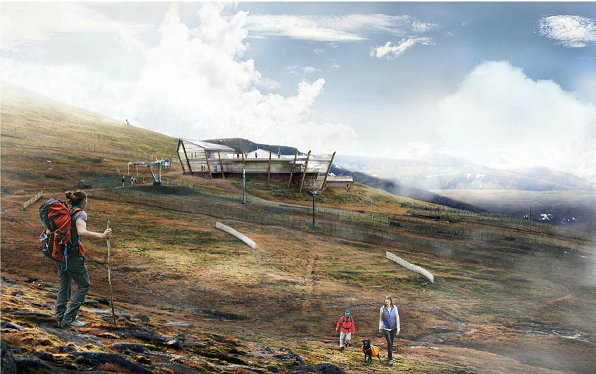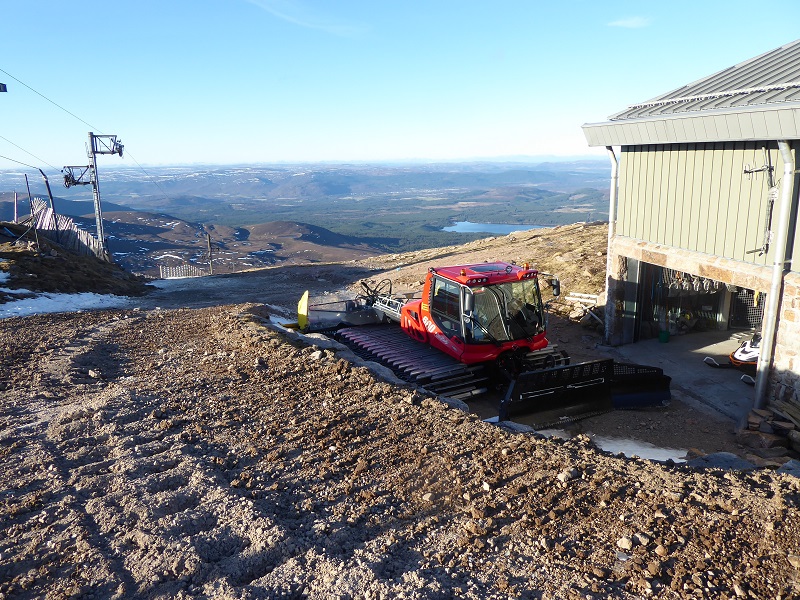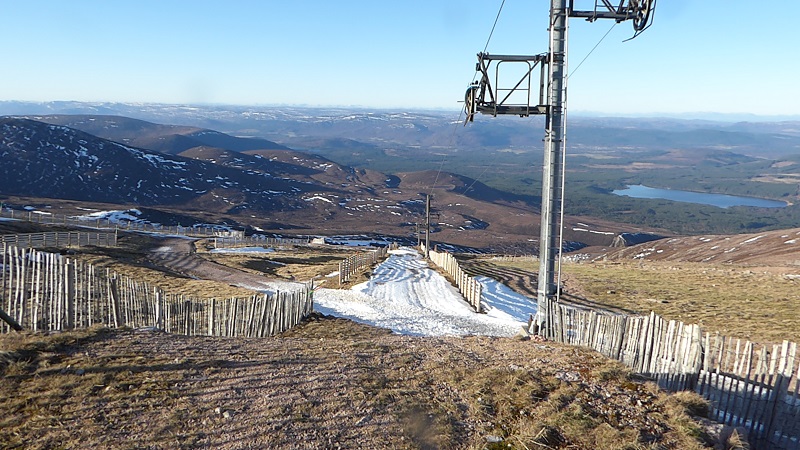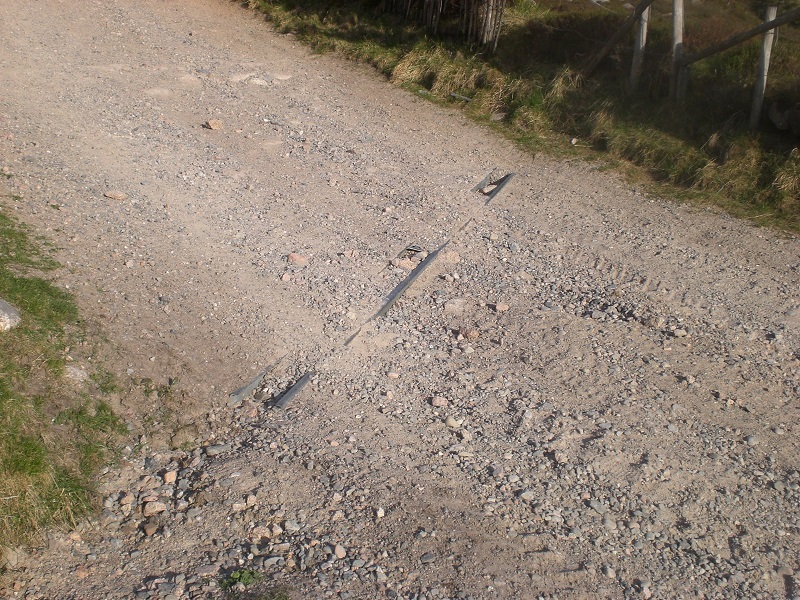
The revised Planning Application to redevelop and expand the Ptarmigan Restaurant near the top of Cairn Gorm is to be considered by the Cairngorms National Park Authority on Friday (see here – item 6). Officers are recommending that the application should be approved. This post explains why CNPA Board Members should reject the application and require Highlands and Islands Enterprise to submit a new masterplan for Cairn Gorm before any further planning applications are considered (see here).
Background – recap
The Planning Application was originally submitted a year ago by Cairngorm Mountain Ltd, as operated by Natural Retreats. HIE had agreed to fund the development with a £2.5m grant (with another £1.5m for the dry ski slope which was later rejected). I blogged at the time about why it was wrong (see here) and (here) and commented on the very limited time the public had been given to respond given the significance of the development. There were only four objections from members of the public.
The Application then entered a black hole for five months until Natural Retreats abandoned Cairn Gorm and Cairngorm Mountain Ltd went into administration. After buying the company back for twice what it had sold it for four years previously and with the infrastructure on Cairn Gorm falling apart due to mismanagement, almost the first action of Highlands and Islands Enterprise was to notify the Cairngorms National Park Authority that it wished to proceed with the Ptarmigan Planning Application.
Then in February a “revised processing agreement” appeared on the Park’s Planning Portal setting out a timescale for processing the application. I blogged about this and the need for a masterplan in early April (see here), completely unaware that the CNPA had in private session at the end of March agreed a set of working principles to cover new developments at Cairn Gorm. These were then made public (see here) and, I was pleased to find, included the requirement for a masterplan, as had been proposed in the draft Local Development Plan.
The need for a masterplan and the Committee report
HIE have still not provided any masterplan. They have also failed to lodged any new paperwork which articulates what in my view was the the misguided and unrealistic vision for Cairn Gorm they launched last year (see here).
There are just two mentions of a masterplan in the Committee Report.
The first,(para 24), states that the Cairngorm and Glenmore Strategy “refers to development of a Cairngorm Mountain masterplan.” The appraisal section of the Committee report then (para 62) dismisses the Strategy claiming that:
“In terms of the principle of development it is noted that the Community Council [well done them!] has raised concern that the application has been submitted in advance of any masterplan for the wider site at Cairngorm Mountain being produced as the Cairngorm and Glenmore Strategy sets out. However, the Cairngorm and Glenmore Strategy is not a planning policy document and the proposals must be considered against the policies of the Local Development Plan.”
The fact that the Cairngorm and Glenmore Strategy is not specifically a planning policy document does NOT mean it shouldn’t be taken into account – treated as a “material consideration” in planning speak. Indeed if the Cairngorm and Glenmore Strategy is so irrelevant why does the Committee Report say this about the strategy:
“The long term direction for the area includes enhancement of visitor infrastructure and facilities to ensure high quality, low impact development, referring to working with on-site businesses to develop plans for the enhancement of visitor facilities at Cairngorm Mountain with the Ptarmigan identified as a site for visitor infrastructure improvements?”
If the Strategy is irrelevant, then so is this sentence. If its not irrelevant, then neither is the requirement in the Strategy for a masterplan. The Committee Report cannot have it both ways.
Strangely, the Committee Report fails to mention the working principles about future developments at Cairn Gorm so recently adopted by the Board. The second of those working principles could not be clearer:
“Any proposals should be part of a masterplan for the ski area as per the proposed new Local Development Plan”.
No reference is made either to the proposed policy in the new Local Development Plan that all new developments in the ski areas in the National Park should be subject to a masterplan. Indeed, the Committee Report attempts to prevent the Board from considering this:
The CNPA is currently considering responses to the Proposed Local Development Plan 2020 and at present this Plan has no additional materiality with regard to decision making for this current application
This is unjustifiable and contrary to the Park’s previous practice. The Committee Report on the Planning Application for the Balavil Hill Road (see here) did make reference to the policy presumption against new hill tracks in the new Local Development Plan, so why not at Cairn Gorm?
It seems to me, therefore, that whatever the Committee Reports says, the CNPA Board have every reason to require HIE to submit a masterplan before taking a decision on this Planning Application. Indeed, if they don’t, they will allow HIE to drive a cart and horses through the develop planning framework that they have been rightly been trying to adopt for Cairn Gorm.
How does the Ptarmigan Application fit with the other Working Principles adopted by the Board?

Besides strategic fit set out in a) and b), most of the other working principles appear to me relevant to the Planning Application. The CNPA Board, however, in announcing the Working Principles which set out their “high level position”, at the same time said that Planning Applications at Cairn Gorm will be “assessed and dealt with in the usual manner”. They did not explain how the Working Principles would apply to individual applications. Perhaps this explains why there is no mention of them in the Committee Report? Unless, however, high level principles can be applied to individual planning applications they are worthless – rather like the CNPA’s presumption against new hill tracks.
Principle C. With Nicola Sturgeon having declared a climate emergency, development planning needs to change and quick. The Ptarmigan Application takes no account of climate change scenarios and there is no assessment of the carbon impact of the new building. This is hardly surprising given HIE’s record on reducing carbon emissions (see here). To be sustainable, new developments need to be carbon neutral. The CNPA already has a policy on Sustainable Design that is half way there: “minimise the effect of the development on climate change in terms of siting, construction and once complete – to achieve at least the minimum standard in compliance with those set out in the Building Standards Technical Handbook “. While the Committee Report assesses the impact of the proposed development in terms of sustainable transport, it fails to mention the CNPA’s policy on sustainable buildings or assess how the extended building would fit with this. Reason enough, one might think, now that the climate emergency is official government policy, to reject the application.
Principle D. The original rationale for the extending the Ptarmigan was that it would attract more people to the funicular and make it viable. With the funicular bust, there is no point going ahead with the Ptarmigan unless it is repaired, a point that is acknowledged in the Committee Report:
it may reasonably be concluded that if the railway is not to be repaired with the duration of any planning permission for the current proposal, then the permission would be unlikely to be implemented, either on a commercial basis or as a good use of public funding.
The problem is that HIE is a Public Authority which has a terrible record in making good use of public funding and is quite capable of using any CNPA approval for the new Ptarmigan to help justify spending loads of money on repairing the funicular. With money for public investment being very limited at present, that would have a serious impact on how much money could be invested in improving ski facilities. The CNPA has rightly committed in principle to creating a good ski experience at Cairngorm and should not be committing to anything that might undermine this.
In terms of current policy, our National Parks have a statutory duty to promote sustainable development and sustainable use of resources. Until the CNPA knows whether repairing the funicular is a sustainable option, they should be taking no decision on the Ptarmigan.
Principle E. Related to Principle d), a new Ptarmigan is unlikely to make any contribution to creating opportunities for all to learn winter sports. Renewing ski infrastructure should be the priority.

Principle F. Keeping people inside the Ptarmigan in summer, as required by the visitor management plan, will make zero contribution to getting more people close to nature and wildness. That is absolutely what Cairn Gorm should be about rather than an indoor attraction high up the mountain that is in clag for much of the year. The viewing platforms will make no appreciable difference to this and are as ill-conceived as Flamingo Land’s abandoned viewing tower at Balloch.
Principle G. As above, HIE have given no indications of how it will finance all the work that is required at Cairn Gorm or what it believes are the priorities. The CNPA has a statutory duty to promote sustainable economic development. That should mean saying NO to things that aren’t.
Principles H and I. (see below).
What’s being proposed?

Apart from the details of the glass -amended to reduce glare and the likelihood of dotterel flying into the windows – the plans for the proposed new extended Ptarmgian building have not been changed:
“new toilet facilities will be provided, a larger café area, new arrival foyer provision with extensive glazing, external decking areas on either side of a new glazed fronted “summit” room which will house conference facilities/meeting room on a second floor. This will be achieved by glazed, sloping extensions around the original building, constructed on stilts/supports.”
“in brief the proposals involve extending the existing building by way of new build on stilts/supports radiating out in an angled manner from the original building so minimising ground impacts and excavations, and at the same time seeking to maximise views out from the building and to improve circulation, accessibility and the facilities on offer.” (Extracts from Committee reports)
What has appeared for the first time is the CNPA’s assessment of the proposed impacts.
The landscape impact of the proposed development
As with the proposed dry ski slope, which the CNPA Board righlty rejected, the Committee Report fails to address the fundamental issues about the appropriateness of a new development high up on Cairn Gorm (which I considered here). It also misrepresents the landscape impact of the proposed development:
“CNPA Landscape Advisor notes in terms of landscape character that the new development will use largely the same pallet of materials and similar geometric form as existing with the increased height relatively modest.”
Comment: actually there will be a very large increase in the amount of glass which will be used in the new building, so it will now appear as a glass structure, and the highest point is TWICE that of the existing building. Compare what is proposed with the existing building:

The new building, instead of lying close to the ground and reflecting the contours around is going to be in your face, an assemblage of angular protusions.

Its an architectural statement, cleverly done, but should have no place high up on Cairn Gorm.
“In this regard the proposed development is clearly related to the existing Ptarmigan at Cairngorm Mountain and will be viewed as an extension and remodelling of the original building, set in a context of ski tows and associated infrastructure.”
Comment: the extension is by definition linked to the old building and located in an area with ski infrastructure but whether it will be viewed the same as the existing development is another matter. Has the CNPA asked the public?
“As a result of the angled design there will be minimal impact in terms of land-take, with the new works effectively encircling the original building in a design radiating out from the original. The most significant change in design terms is the summit tower component which is designed to match the overall concept, and provides an interesting and innovative feature.”
Comment: Whether the summit tower is an innovative feature is again a matter of opinion. You could equally see this as the Flamingo-isation of Cairn Gorm.

Given the ground around the existing Ptarmigan has been totally trashed, the fact the glass extension is on stilts appears irrelevant in terms of minimising the environmental footprint. In any case the ecology of the ground below the new structure will be totally altered by having a “roof” above
“The style and design is in keeping with the character of the ski resort and presents no significant change in character. . Similarly the use of angled glass is also in keeping and there is a positive effect from this in that it may reduce reflection and flare from low level sunshine which at the moment can draw attention to the building.”
Comment: this is nonsense. Most of the ski area looks something like this;

Leaving aside the question of whether the impacts of the existing ski infrastructure might be better managed, the new building clearly introduces something very different into this landscape.
67. Supporting landscape material has demonstrated how the new facility will sit in this landscape. Whilst it will inevitably be visible from the immediate surrounding area and further afield these impacts will be minor and clearly related to extending an existing building. The design itself is considered to be entirely appropriate to the location in landscape terms and has been informed by its location, designed to take advantage of the outstanding views here whilst minimising impact on the sensitive montane environment, and delivering angled viewing platforms which in terms of both function and appearance are considered to represent an enhancement to the existing design.
Comment: what design wouldn’t be “considered to be entirely appropriate to the location in landscape terms”? The CNPA Board should question this judgement. What officers should be doing is telling the truth, that the design will totally alter the appearance of the building and people’s experience at the top of Cairn Gorm. Whether that’s a good thing or not can then be subject to public debate.
The proposed construction method and the access track
While the designs for the building may not have changed, the proposals of how to build it have. I previously expressed scepticism that HIE would ever pay for the materials to be brought in by helicopter as originally proposed. Suddenly, the revised application introduces the risk of helicopter collision with dotterel to rule that out. If this is such a risk, and the Ptarmigan is not even within the Special Protection Area, to be consistent the CNPA should now be calling for a moratorium on all helicopter rescues in the Cairngorms. I look forward to that seeing them try to do this but until then will maintain that dotterel are being used as an excuse to save money and trash Cairn Gorm further.
The Committee Report is almost entirely silent on how the new building will be constructed. The revised Construction Method Statement indicates the preferred option is to transport all the materials up in winter using snow machines to minimise ground impact. All the materials would then be stored adjacent to the Ptarmigan until work can start the following summer. This is almost certainly completely unworkable.
The fallback option proposed is to improve the existing track, which was originally intended to provide temporary access for the funicular construction. No details have been submitted by HIE about how they propose to do this. The Committee Report fails to consider the issues, including the landscape impact, and does not propose any conditions requiring HIE to submit detailed proposals on how they should do this.
The context for this is that HIE’s record on track construction (see here for example) and maintenance at Cairn Gorm is appalling.

Even with staff idle due to the funicular closure, HIE has done no basic maintenance on the access road with the consequence that water drainage channels are blocked, water flows down the road and its surface is eroded more rapidly than otherwise would happen. The road is too steep in parts anyway and the regular use of heavy tracked vehicles in conditions of poor snow cover exacerbates the problems.

Whatever the CNPA Board decide about the Ptarmigan tomorrow, they should require HIE to submit a separate Planning Application for any work on the access track to the Ptarmigan. They have set a precedent for this with the Planning Applications for the Glen Banchor and Atholl Estates (see here), one of which is also on the agenda for tomorrow’s meeting!
The Ptarmigan Planning Application and the wider planning system
The Committee Report on the Ptarmigan Planning Application is not all bad. Considerable care, for example, has been taken to try and minimise the impact of all the new glass windows on bird strike, reflective glare and light pollution at night. The problem that planning staff face, however, is that increasingly planning has been reduced to a technical and legalistic exercise. While this can be expensive and time consuming for developers, it ultimately favours them because once they have ticked various boxes, development is almost invariably assured. Within this context, unless Planners can point to an explicit planning policy that rules out a development, they risk being subject to legal challenge from the developer. Hence most planning applications are approved.
In the case of landscape, landscape policies are invariably vague and, having conducted a technical landscape visual assessment, there are almost no effective limitations on development. The general presumption appears to be that any development has received a degree of mitigation – such as the blinds to limit light pollution – it should just go ahead. The public, who care more about landscape than almost anything else, and could change how landscape is treated are generally excluded from the whole process. This is then left to “professional judgement”. All the professionals involved, whether those paid for by the developer to conduct the assessments or Planning Authority staff, are then under pressure to get the application approved. In the case of Public Authorities, if staff stand up against development, budgets are likely to be cut. The result is we end up with opinions, whether “owned” or not, presented as professional assessment and judgement which are written to get developments through the system.
What Planning should be about is People and Places. The Ptarmigan Planning Application presents an ideal opportunity for the CNPA Board to assert this and take back control. Instead of deciding the application by selective references to their current planning policies, they need to stick to their guns, insist that a proper masterplan is needed and then within that context consider how the principles they have developed should be applied. Even better, as part of this, they could consult on the principles they have adopted – that would give them more weight. On landscape matters, such as whether the design of the Ptarmigan extension is in keeping with the landscape or not, they should start with their gut reactions. Those should be based on a site visit or drone footage which allows them to compare what is there now to what is proposed. They could then usefully insist that developers and their own staff took far more cognizance of what the public thinks and then use that to inform decision making.

It is an unfortunate consequence of timing that I was personally not able to lodge an objection to this proposal when it was lodged, being a CNPA Board member at the time, and it is also unfortunate that the circumstances have changed such that this application, by Natural Retreats, has been continued by HIE, who can therefore claim that this particular application pre-dates the decision by the CNPA to require a masterplan for the hill. HIE can legitimately claim therefore that the application can be determined independently of any future masterplan. But the idea of even thinking about spending money on such a development to enhance the summer visitor experience when at present there is no possible means of summer access barring walking or, for the nouveau riche, a helicopter, must surely be more than just a business consideration – it must be a legitimate planning consideration too. This would logically follow, since a favourable determination of this application would imply a future tacit acceptance, in planning terms, that it makes sense to continue to provide a means of summer access to the elevated position of the Ptarmigan. Yet there are legitimate doubts – or at the very least, concerns, that continued high level summer access may not ultimately be the best approach. I would argue strongly that in the new circumstances of both changed management, and doubts on the future of the funicular, the application at this stage and in this form is premature, incomplete and potentially damaging and should be rejected. I hope the new Planning Committee do so, and show that their commitment to a masterplan approach and completed review process is expected and must be delivered. It is more important to take time and get this right than to create knee-jerk solutions, as HIE themselves stated often enough.
I understand that the CNPA Planning Committee approved this ill-conceived application today without even a vote – i.e. unanimous decision. I also understand that our CNPA Planning Authority (or at least the planners themselves) do not consider that their newly issued Cairngorm Mountain – CNPA Working Principles document has much strength as a planning document. In the CNPA Planners ‘eyes’ it seems to have similar low standing to the Cairngorm and Glenmore Strategy Plan. So it appears that the Working Principles document is just no much more than window dressing.
If this is true, then the CNPA Board needs to ask its Head of Planning to take steps to make this document (and the Cairngorm and Glemore Strategy Plan) ‘important’ planning documents for Cairn Gorm. For example, it shouldn’t be too late for these document to be included as policy in the new Local Development Plan. If he can’t or won’t do this, then we need to ask why we are employing him!
Great piece of investigative work again ,Nick.A number of folk have suggested the daftness of plans for a venue that is currently so inaccessible. There have been,I think,housing plans in the Strath knocked back because of concerns about the disturbance caused by construction vehicles access requirements. Surely there is a concern that building material transfer would cause unacceptable damage to the hill.Or does that mean the funicular must be reinstated never mind the cost? I suppose formal objections had to be lodged by the appropriate date.I suppose too that the newly elected Board would have been advised that there was no allowable grounds for refusal? Hence the unanimity or is that a misreading? It does seem odd that HIE can use public funds to ensure their plans meet the required criteria for their “vision” for their estate. And that vision is realisable only with public money.
There`s an awful contrast with the CEO of Wildlands recent setting out of vision, spending and self awareness(Strathy,May 16th) and the uncommunicative HIE.
I think,Nick that you suggested that there was no way these folk in your first image could be wandering out from the Ptarmigan. Might not that be an imagined image in December or January? All the best!
I attended the planning committee meeting held at the Lecht ski centre yesterday. There was consternation expressed by several of the planning committee members about the fact that no Masterplan for the future development of the CairnGorm Mountain business has yet been produced. The previous tenant was expected to deliver it but as with everything else….they failed. HIE haven’t managed to deliver that either. However, the committee were advised that the lack of a Masterplan wasn’t a material consideration with respect to this planning application and it was therefore eased through. Only time will tell if it is ever taken to the construction phase. My personal view is that HIE will be pleased to be able to point to the planning consent as a lever to help to ensure that the Funicular is fixed……at any cost. They are utterly fixated on the Funicular and are completely blind to the fact that their Funicular centred Strategy has left the hill business with nowhere to go now that it is broken. Notably, no work has yet begun to repair it and I doubt that much will happen this year. It would be no surprise if it was out of service over the next 2 winters and that will bring continuing disaster to the local economy